Reviewed by Glenn Erickson
Neither French director Georges Franju nor his movies have received due respect on video, as his marvelous Eyes Without a Face (Les yeux sans visage) is still his only B&W movie available in a U.S. edition. The New Wave critics considered him too old-school even as they worshipped cinema at the institution he co-founded, the Cinémathèque Française. Franju's quietly affecting pictures are best experienced in a large auditorium with a hushed audience, the better to appreciate their delicate cinematography and impressive music -- perhaps the most original, if still-obscure, film scores by the great Maurice Jarre.
Some new viewers don't get what all the quiet, slow buildup is about in Eyes. Franju's horrors are a matter of hesitant gestures, furtive looks, slowly closing doors and staring eyes. A rich, arrogant doctor commits atrocities out of professional hubris, suggesting a connection with Nazi experiments. Unlike most horror films, this one suggests even greater horrors.
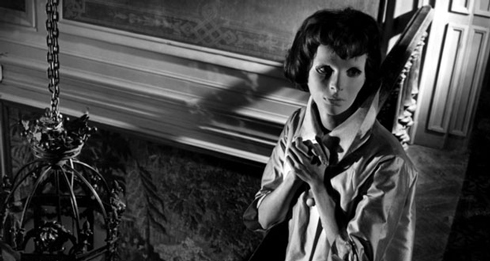
Eyes Without a Face is an exceptional film in every way. It challenges the boundaries of what was then a comparably tame genre. Despite its then-outrageous gore content it's not presented or structured as an exploitation movie. It stands apart from the glut of commercially oriented Euro-horror that had started a couple of years before. It's from France, a country that loves horror movies but doesn't make many. Exquisite visuals collide with intolerably inhumane content. Director Franju channels the poetic surrealism of Jean Cocteau into the contours of the horror film. The immediate reference has to be Cocteau's fantastic Blood of a Poet and Beauty and the Beast. It also harks back to the silent work of Louis Feuillade, especially Fantomas and Judex, which director Georges Franju would remake with similar fantastic imagery.
In a grim, cold cemetery outside Paris, noted surgeon and neurologist Doctor Génessier (Pierre Brasseur) buries his drowned and mutilated daughter Christiane, much to the concern of his aide/secretary Louise (Alida Valli) and his medical intern Jacques Vernon, Christiane's forlorn fiancé. But back at Génessier's foggy country clinic Christiane (Edith Scob) is very much alive, hiding in the family mansion and wandering deranged through the corridors in a mysterious blank-faced mask. Louise spends her days stalking students outside the Sorbonne, looking for young women with eyes and skin that match Christiane's...
Raymond Durgnat's late 'sixties film criticism identified the relationship between 'poetry and pulp' that presented pop entertainments like Batman and This Island Earth as work important to the culture. Durgnat pegged George Franju's unique Eyes Without a Face as the pinnacle of the horror film, graduated from fumbling exploitation to a clear poetic expression. As there's almost no other horror film with a similar impact, Les Yeux sans Visage isn't easily described.
It's slow and deliberate. The visuals present an orderly world of a doctor completely above suspicion, conducting his atrocious work secure from detection. Paris and its environs are overcast and foggy. Leafless trees dominate grey skies. The police go about their business with sincere good will, but are ineffective.
The villains are mysterious and banal at the same time. Like the workaday monsters of the concentration camps or the butchers of Blood of the Beasts (Franju's groundbreaking docu short subject included here as an extra), Dr. Génessier and his devoted assistant Louise don't profess mad theories or rationalize what they're doing. They kidnap, mutilate and murder innocent young girls, work that to them is deplorable but necessary. Génessier isn't a madman; he's the kind of professional so impressed with himself that he's too proud to admit an error. He loves his daughter and shows concern for his patients, but his real love is his own achievement in surgical heterografts -- the transplanting of organs or tissue from one person to another. Like H.G. Wells' Dr. Moreau, he considers himself and his science above morality and the law. But Génessier's wealth and respectability -- he's an profoundly closed-off man -- allow him to do what he pleases without running away to a mad lab on a remote island. His surname sounds like Genesis, suggesting the Frankenstein cliché of the doctor who aspires to usurp God's domain. The doctor is haughty, domineering and utterly convinced of the rightness of his actions.
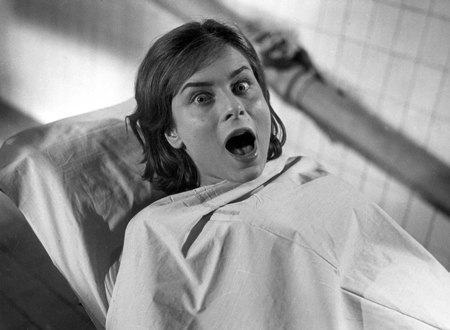
Louise is even a bigger mystery. She's the doctor's assistant and probably his lover. As described by Durgnat, Louise's doglike devotion is indicated by her pearl necklace which hides a scar, the only evidence that Génessier has changed her face. We don't know why Louise was given a new face, and we don't know if Louise was always Louise. What became of Génessier's late wife, who has not been dead for long? Is Louise to grateful her surgeon-lover out of pure love, or did he use his talent to help her evade some unpleasant crime? Louise shows signs of anxiety with the doctor but puts up a flawless facade with the daughter Christiane. Her devotion to both of them is genuine, even as she has no problem trapping helpless female victims and imprisoning them in a dungeon. The upscale Eyes without a Face shares ideas with the trashy but fascinating plastic surgery exploitation epic Circus of Horrors.
Edith Scob's Christiane is the soul and the center of the film. Maurice Jarre's music expresses the black velvet nightmare of her existence, providing a delicate accompaniment as she glides like a phantom through the brick corridors of her father's mad surgery. Christiane indeed haunts the house of Génessier. Another girl is buried in her stead, and she talks about having to live for "the others" as well. All the mirrors have been blacked over. Christiane visits the caged dogs used in her father's heterograft experiments. Every so often she sneaks a phone call to hear the voice of her fiancé Jacques.
Christiane's 'face' is a neutral mask without eyebrows, a dead mannequin's face through which stare Scob's maddened eyes. It has all been stylized to resemble artwork by Jean Cocteau. She walks and moves with exaggerated grace, an image augmented by her housecoat with its upturned collar and short sleeves. It's unnerving to see Christine step slowly down a dark brick hallway, while her father's tortured dogs howl from off-screen.
Eyes Without a Face has horror aplenty, but it requires patience. 1 The famous surgery scene is a centerpiece that becomes less important with repeated viewings. The cool precision of the professional surgeon presides over the destruction of beauty. We see that the human image we most identify with, the face, can be taken apart in less time that it takes to carve a Thanksgiving turkey. The skin is an organ not firmly attached to most of the viscera below it, and Génessier has no problem lifting an entire mask-like graft section in one piece. 2 To actually visualize such a process in a film must have been anathema in 1959; Franju's story is not specifically about animal vivisection or Nazi medical experiments, but the spirit is there in force.
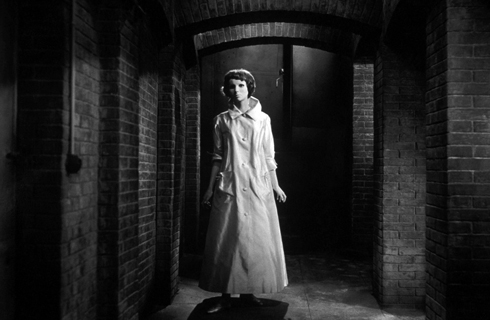
The film's aesthetics suggest existential horrors beyond the 'controlled anarchy' of the Feuillade serials and Cocteau fantasies. Génessier's manse is hidden deep in a mysterious-looking wood. The secret surgery is perhaps his old facility before the modern clinic was built, a tile-and-concrete bunker laced with piping and filled with chrome tables and instruments. Rolling steel doors separate rooms. The spooky brickyard morgue in Paris lies alongside a sad railway. With a little imagination it might be carrying souls from one world to the next.
Raymond Durgnat (always back to Durgnat) stresses the importance of textures in Franju's film. The doctor's sleek Citroën sedan reflects dead trees like a mirror, while Louise's ugly DS vehicle has a corrugated surface. Louise and Edna wear shiny plasticized raincoats. Christiane's mask is velvety and featureless while her ravaged face (out of focus) looks like eroded and furrowed ground. Maurice Jarre's music has textures as well. The jangling 'icy-black death waltz' of Louise's stalking theme contrasts with the impossibly gentle tune that seems to represent Christiane's dreamy madness.
Franju's star Pierre Brasseur (Children of Paradise) is imposingly cold as the doctor. Alida Valli is no longer the to-die-for beauty of The Paradine Case and The Third Man. Her demise is modeled somewhat after that of Vera Clouzot in Les Diaboliques, a more conventional murder thriller from the same French writers, Bouileau-Narcejac. Juliette Mayniel (Les cousins) and Béatrice Altariba are the Doctor's intended victims. Coincidentally, the exact same victims-in-peril structure was used by Alfred Hitchcock for the next year's Psycho. Hitch may have been well aware of the Franju film; his Vertigo is from a book by the same authors.
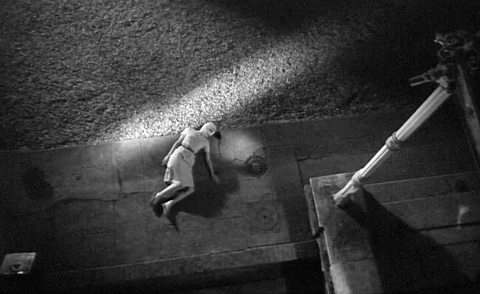
Eyes Without a Face is often called a 'seminal' film because it has influenced so many pictures that followed. Medical horror films were already a mini-genre in Mexico, and several notable precursors feature mad scientists restoring the looks of horribly mutilated wives and lovers by stealing the blood of female victims -- the hoary cliché surely goes back to horror pulp fiction. But the majority of the films are trashy junk like She Demons. Nothing involving mad surgery after Eyes Without a Face is as thematically complex. Mill of the Stone Women and Gritos en la noche appear to be directly inspired by the Franju film.
My editor friend Steve Nielson compares Les yeux sans visage to, of all things, the rock band Velvet Underground. Quote: "Not many people bought their records, but everyone that did started a band!" 3
Some critics in 1959 were offended by Franju's 'terrible taste' and his refusal to make moral judgments. It was not a big success in its own time - horror films were popular, but distributors avoided truly disturbing productions. The idea of a cult film hadn't yet been invented; Eyes Without a Face instead became a cornerstone film in a new category of transgressive horrors discussed by fans of "dangerous" fare, such as Peeping Tom and Blood and Roses (...Et mourir de plaisir).
Attempts to analyze this uncanny horror film have undone many a reviewer. Judith Crist thought Eyes Without a Face to be a confused story about medical ethics. It appears to me an expression of the willingness of 'enlightened 'modern men to victimize others for self-benefit. Like Charity, Cruelty begins at home. Any family, city or country will 'allow' others to suffer if it means helping our own, our children, ourselves. The Doctor doesn't concern himself with the price others pay so long as his pride in his profession is maintained. He'll kill to restore his daughter but even that goal is secondary to maintaining his lofty self-image. 4
Criterion's Blu-ray of Eyes Without a Face is an HD upgrade with one attractive new extra. The original DVD looks so good that one might not be able to see the improvement on a smaller monitor. Cinematographer Eugen Shuftan's full range of soft gray tones give the show its uncanny textures. Blu-ray's lossless audio presents Maurice Jarre's amazing music score at its best. The sharp violin notes in the title scenes now cut like a razor, and the echo-y sound of dogs barking in Génessier's horror chamber is unnerving.
This version is intact: images have circulated of a slightly longer alternate ending reportedly never incorporated into the film. The additional sharpness highlights horrifying details. We get a good look at the flayed face of the lumpen corpse in the back of Alida Valli's little car. The final shot of Dr. Génessier clearly shows his eye to be torn free of its socket. George's Franju stages these shocks in a chillingly matter-of-fact way. 5
The previous extras are all present, beginning with the short subject The Blood of Beasts, a sly documentary about two Paris slaughterhouses that made Franju's reputation as a notorious filmmaker. Anyone who eats meat needs to see this; on a literal level it rubs our complacent noses in the daily carnage that supports our way of life. On the other hand, Franju's completely neutral point of view again abstains from enforcing a set message, allowing us to provide our own. The reduction of mass killing into a mundane and orderly routine conjures nightmare visions of concentration camps, if only because our mental tendency is to compartmentalize similar horrors together.
A short Franju interview repeats most of the stories we've already read in print. It is set in a demeaning 'mad lab' TV set with bubbling colored liquids and a costumed horror host. Better is Grandfathers of Crime, a 'two authors at home' visit with the genial Gallic thriller team of Boileau-Narcejac. Of special interest to horror fans is a wide selection of international ad artwork and the beautiful stills that accompanied the original release.

Also present is a mysterious, highly creepy original French trailer. It is accompanied by an impossibly exploitative Lopert trailer for the U.S. exploitation double bill of The Horror Chamber of Dr. Faustus and The Manster. Unlike the teasing French coming attraction that barely shows an image of Christiane, the Lopert mish-mosh splashes garish text across the screen and announces that a reviewer likened the classic film to "Tennessee Williams in one of his more abnormal moods." It samples every gory scene and misidentifies Edith Scob as Juliette Mayniel. The Horror Chamber of Dr. Faustus is a dubbed and trimmed version that dropped a couple of scenes, including Dr. Génessier's kind examination of a boy with an unexplained neurological dysfunction. But it was still plenty scary. 6
The Blu-ray's new item is an interview with the still-active actress Edith Scob, who talks about her role in Franju's Head Against the Wall and offers her take on Eyes along with her personal memories of the director. She even describes what wearing the mask was like -- once she had the thing on, it had to remain on for hours.
An insert flyer features short essays by Patrick McGrath and the esteemed David Kalat. Reading their praise, some curious fans will see Eyes Without a Face and then ask what the big deal is. The deliberately paced film spends more time contemplating horror than dishing it out by the bucketful. But viewers tired of cookie-cutter horror films and who respond to magical masterpieces like Beauty and the Beast will be amply rewarded. Eyes Without a Face is far, far too good to be only a cult film.
On a scale of Excellent, Good, Fair, and Poor,
Eyes Without a Face Blu-ray rates:
Movie: Excellent
Video: Excellent
Sound: Excellent
Supplements: Interview with actress Edith Scob, Franju short film The Blood of Beasts, TV interviews, artwork and stills, trailers, essays.
Deaf and Hearing-impaired Friendly?
YES; Subtitles: English
Packaging: Keep case
Reviewed: October 17, 2013
Footnotes:
1. At a Filmex 1980 screening, the majority of the packed Fairfax theater seemed never to have heard of the film. The audience was irritated and surly until Edna was chloroformed and Génessier threw the cloth into the fireplace. When it burst into flame the whole house went nuts with approval. From then on Franju had them in his pocket.
Return
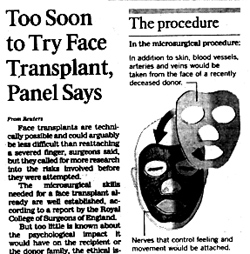
L.A. Times, November 22, 2003
2. The bizarre fact is that although current standards of gore have surpassed the surgery scene for realism, today's doctors are now actually transplanting faces in the same manner as this film's medical criminal. What will the future hold? Will face donors be recruited like today's organ donors? Will Third World families sell their daughters' faces the way they already do kidneys? Will we see a movie called Dirty Pretty Faces?
I think that it's pretty incredible that the 'heterografts' in Franju's movie look exactly like the drawing in the newspaper clipping, just above.
I once had a dream of an idea that I later read was a reality. A person needs a piece of skin to cover some terrible burn. Instead of finding a suitable heterograft donor and struggling with tissue rejection, the doctors create a 'homograft' from the person's own body. An expanding plastic disc is inserted into one's hip, perhaps. In the same way an orthodontist stresses braces on one's teeth, the doctor makes the disc larger by inserting a screwdriver and adjusting it. As soon as one's skin grows to accommodate the larger disc, the disc is adjusted even larger. Finally, one has a big flap of skin and flesh that can be cut free and used elsewhere on the body. It's one's own skin, so there's no rejection. The patient goes through some weeks of discomfort but the process is no different than the extra skin area that grows when one gains weight. It all seems to be possible.
Return
3. The Liz Taylor film Ash Wednesday has two sequences showing real cosmetic surgery in Technicolor close-up. The scenes overpower the forgettable soap opera in between. Plastic surgeons that perform facelifts for famous stars and millionaires are a coddled and incredibly well rewarded select group.
I once saw a 60 Minutes interview with a French specialist in plastic surgery who learned his craft patching together war wounded. He was impossibly puffed-up and self-important and regaled the interviewer with stories of his unique talents and techniques. When it comes to surgery, we all want someone so skilled that our particular problem is his routine miracle. But this guy behaved like a Génessier in the making.
Return
4. Without elaborating I'll say that my take on the film is essentially political. Génessier is a self-appointed elitist perfectly willing to 'spend' the lives of others to suit his personal interest.
Return
5. What makes the film art instead of exploitation? (a) Franju is not selling the gore as his main entertainment, and (2) he has the courage of his convictions. Savant edited two low-budget horror pictures. One of them is a sleazy film about a devil worshipper with a secret torture chamber. The director approved the exploitative script and hired a willing actress to be trussed up in explicit bondage paraphernalia, tortured and slaughtered. As the movie had little going for it in other departments and was going to get a punitive rating anyway, I tried for weeks to get the director to keep the sequence as rough as we could make it. I finally found out that my director hadn't thought enough about the movie to realize how sleazy it was. He'd keep taking VHS dubs of our cut home to show his wife, who hit the ceiling each time. No matter what reasoning I used, he talked himself into thinking he was making a 'nice' movie and had me delete most of the nastiness. So the movie turned out a hypocritical, castrated mess.
Return
6. I'm proud to be listed in the 'thanks' list for this disc; I remembered that film collector Mike Heenan in Phoenix had the rare Faustus/Manster trailer and put him in touch with the people at Criterion.
Return

DVD Savant Text © Copyright 2013 Glenn Erickson
See more exclusive reviews on the Savant Main Page.
Reviews on the Savant main site have additional credits information and are often updated and annotated with reader input and graphics.
Also, don't forget the
2011 Savant Wish List.
T'was Ever Thus.
Return to Top of Page
|

